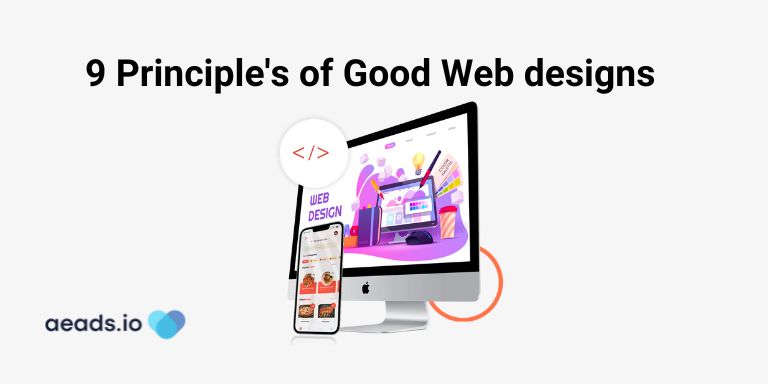9 Principles of Good Web designs

A well-designed website should achieve its goals, which include enlightening and entertaining site visitors. Consistency in color, font, imagery, ease of use, and functionality are all crucial components of a well-designed website.
The extent to which a website successfully conveys its intended message depends on several elements. A website's design can influence a user's level of trust and motivation. Making a website that is both aesthetically pleasing and easy to navigate is crucial to providing a satisfying experience to visitors.
Here are some things to remember as you plan your next web project.
1. Goal of the website
Your website should be taken into account when designing your website. By stating your goal on each page, you will make it easier for visitors to engage with the content. Why do you have this website? Are you providing instructional advice similar to a "howto" manual? Do you provide sports reporting, or are you trying to sell anything to the user?
Defining Expertise
Establishing Your Credibility
Potential Customer Lead Generation
Transactional and Follow-Up Support Services
2. Ease of use
When designing your website with the end user, keep things as simple as possible. Several examples of minimalist design are provided below.
Colour
Identifying a color scheme for your company's image will help shape how consumers feel about your product. Keep the palette at fewer than five colors. Aesthetically pleasing color schemes boost user satisfaction and loyalty.
Type
In terms of usability, typography on your website is crucial. It attracts focus and serves as a visual representation of the brand's tone of voice. The website should utilize no more than three distinct typefaces, all of which are easily legible.
Imagery
Imagery encompasses all forms of visual content employed in communication. The term "graphics" includes both static and moving images. All visuals should be expressive, conveying the company's values and ethos while also conveying a sense of fun and playfulness that is integral to the brand. Most of the first information we take in from a website is visual, so it's crucial to make an excellent first impression with images that convey professionalism and reliability.
3. Navigation
The navigation system of a website is the means through which users navigate to content. Easy site navigation is essential for keeping visitors engaged. Visitors will leave a site that is difficult to navigate. Maintaining a consistent, user-friendly navigation structure across all pages is vital.
4. F-Shape Pattern Interpretation
The F- based pattern is the most prevalent method for users to scan text on a website. Eye-tracking research has shown that people tend to focus on the screen's upper left and upper right corners. The F-shaped design is typical of how most of us in the West naturally read (left to right and top to bottom). When done right, a website's layout should complement how a reader scans the page.
5. Visual hierarchy
Visual hierarchy refers to the order in which visual elements are presented. This can be achieved using several design elements such as scale, hue, texture, style, contrast, typeface, white space, and imagery. One of the visual hierarchy's primary roles is to provide a focal point, directing users' attention to what's genuinely crucial about a page.
6. Content
An effective website has both outstanding design and great content. Good content can entice and persuade readers to become buyers if written with persuasive language.
7. Grid-Based Layout
Designing with grids allows you to organize your information better and maintain a consistent visual style. The grid helps to arrange components on the page and keep it neat. The grid-based style creates a satisfying visual experience by organizing content into neat, uniform columns and sections that all line up and feel balanced.
8. Loading Time
If a website takes too long to load, potential customers will leave. Nearly half of all website visitors have a three-second tolerance for slow page loads before they move on. Improving your site's load time is as simple as optimizing your picture sizes.
9. Mobile-Friendly
There has been a rise in the use of mobile devices for Internet access. You should consider making your site responsive to look well on any size screen.
These are the nine broad guidelines that should be followed when creating a website. Using these guidelines, creating websites that are both accessible and useful is a breeze. Creating a good and user-friendly website without these foundational elements would be challenging. Keep in mind that the most successful websites are user-friendly and usable in the real world. With AE ADS, Dubai ensures your following website is built with scalability to attract more users and generate more revenue.
